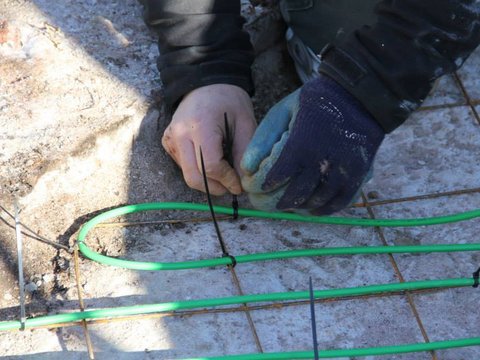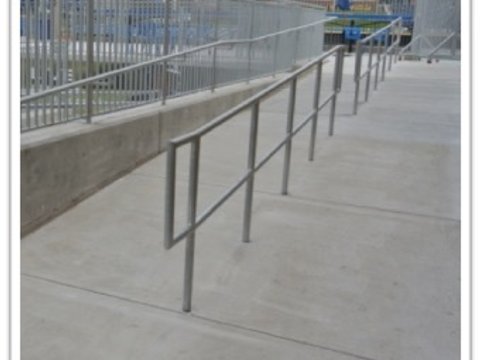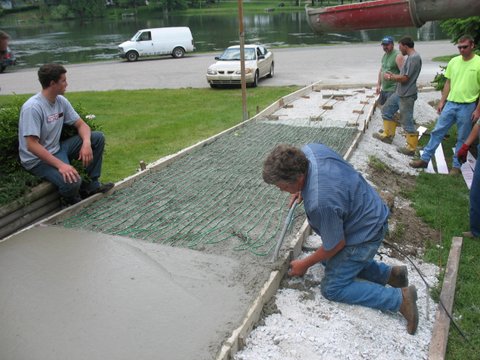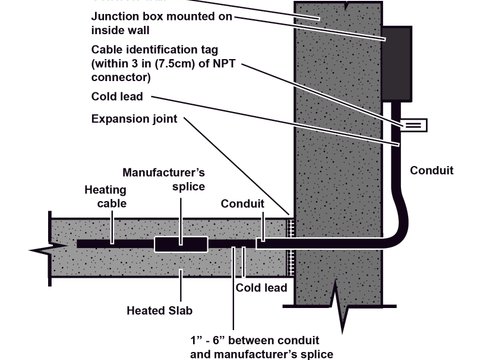Snow Melting for Heated Walkways & Paths

When snow and ice accumulate on outdoor walkways and paths, it can create hazardous conditions and impede access.
Our innovative snow melting systems use electric heating cables and mats installed under the surface to gently melt snow as it falls. This keeps walkways, patios, and paths clear for safe outdoor access throughout the winter.
With customized design assistance from our snow melting specialists, we create systems tailored to the unique layouts and climate challenges of your property.
Why Heat Your Walkways & Paths?
What is Snow Melting?
Have you ever seen snow fall on an already warm car? It melts instantly. This is the essential idea behind snow melting systems—a heating element is embedded in your walkway and it melts the snow that falls on it.
Walkways and pathways benefit greatly from a WarmlyYours snow melting system (available in both mats and cables). Designed to install directly in concrete, asphalt, or in mortar beneath pavers, our systems ensure safe passage year-round.
Because electric systems are modular, they can easily be expanded in the future if you decide to add heated driveways or patios.
Learn More About Snow MeltingFree SmartPlan
Get a custom installation plan for your walkway or path in just 1 business day.

"I'll design a custom snow melting layout for your project, complete with cable spacing, electrical requirements, and a full quote."
When to Install a Snow Melting System
Because the snow melting system is embedded within the surface itself, the best time to install is when a walkway or path is being created for the first time, redone, or expanded.
These projects are typically undertaken from late spring to late fall when ground temperatures are above freezing.
The example pictured is of a walkway improvement that will double as an accessibility ramp, leading to a detached garage for wheelchair accessible van access.
By adding the snow melting system, the customer is sure to have a clean path to the garage without relying on a snow removal service.
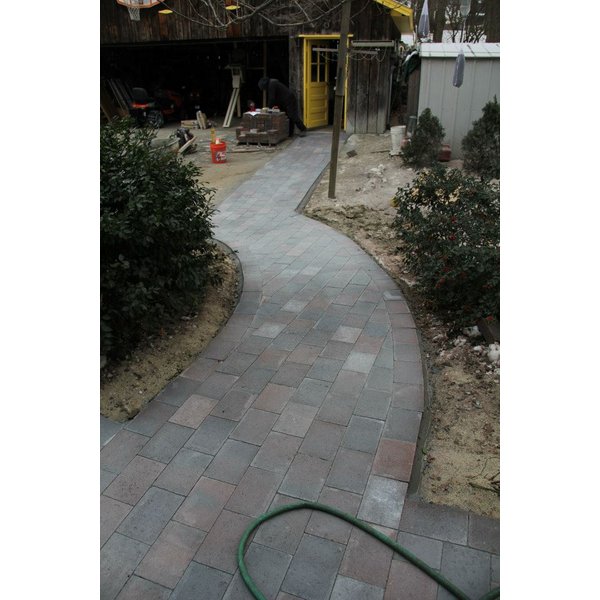
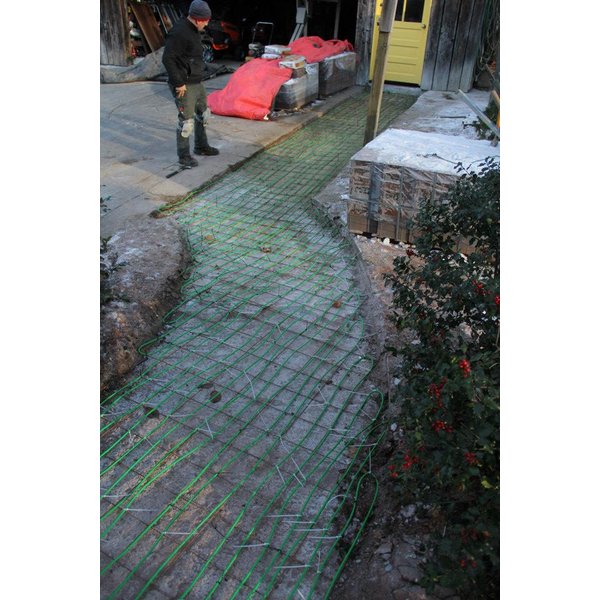
Installing the Snow Melting System
The thinness of an electrical snow melting system means minimal impact on overall walkway depth. These systems work with concrete, pavers, and asphalt—each surface type has different depth requirements.
Follow these steps for a successful walkway installation:
Step 1. Laying Down a Rebar Frame or Wire Mesh
For snow melting cables, include a rigid framework for the heating elements to attach to. This ensures proper spacing and depth.
Secure the framework so it lies flat, then attach cables with zip-ties.
Step 2. Start Laying Out Snow Melting Cables
Maintain 3" (76mm) spacing for free-form cables. Snow melting mats already have the desired 3" spacing built in.
Reference your free WarmlyYours SmartPlan for proper layout guidance.
Step 3. Preparation for Handrails
For walkways with handrails, install pre-sleeves for the posts to avoid drilling through the finished surface.
Route heating cable around sleeves—never allow direct contact with metal fixtures.
Step 4. Installing the Surface
For concrete: use 1-stage or 2-stage pours with heating element 2-3" below finished surface. For pavers: cover with 1"–1.5" of mortar.
Avoid dropping pavers into place as this may damage the heating element.
Step 5. Embed the Manufacturer's Splice
A common mistake is leaving the splice outside of the concrete or sand. This causes the splice to overheat and fail.
Always embed the splice in concrete, sand, or stone dust to prevent overheating.
The Finished Heated Walkway
Once completed, your walkway is ready for use. Just add snow! Monitor your system during the first few snowfalls.
Systems continue running after snowfall ends to evaporate remaining water, leaving clean, dry surfaces.
Controls for Walkway Snow Melting
WarmlyYours offers a wide variety of controls—from manual options with timers to automatic controls that activate when they sense snow is falling.
Controls use two main types of sensors: slab sensors (installed with the heating element to measure surface conditions) and aerial sensors (installed in the open to detect snowfall). Note: slab sensors are not recommended for use with pavers.
For more information, check out this comparison chart.
Shop ControlsSnow Melting Products for Walkways & Paths
Cables offer maximum flexibility for custom layouts, while mats provide faster installation for straight sections.

Maximum Flexibility at a Minimal Cost
-
High Heat Output: This embeddable electric heating cable provides 12-watts of heat per linear foot (nearly 50-watts per sq. ft.)
-
Embeddable in Concrete, Asphalt, or in Mortar Under Pavers: Installing a cable-based snow melting system within a new driveway, walkway, or patio means you can enjoy snow/ice free outdoor surfaces all year
-
Cost-Effective and Flexible: Snow melting cables are an less expensive (but more time consuming) alternative to snow melting mats and they provide maximum flexibility to cover round driveways, cornered patios, or outdoor stairs
-
Wide Variety of Voltages: We offer snow melting cables in 120, 208, 240, and 277 voltages and in a range of different lengths
-
Installation Support: WarmlyYours offers free SmartPlan™ installation plans, 24/7 phone support, and a 10-year limited warranty

Maximum Heat Density for Heavy Snowfall (3" spacing)
-
Maximum Heat Output: Approximately 50-watts per sq. ft with 3" cable spacing for fastest snow melting
-
Best for Heavy Snowfall: Recommended for regions with 60+ inches of annual snowfall or when rapid melting is critical
-
Even Heating: Pre-attached heating elements in a serpentine pattern with consistent 3" spacing ensures uniform coverage
-
Fast and Easy Installation: Cut-and-turn design makes installation faster than cables while providing maximum heat density
-
Installation Support: Free SmartPlan™ installation plans, 24/7 phone support, and a 10-year limited warranty

Optimal Performance & Energy Balance (4" spacing)
-
Balanced Heat Output: Approximately 39-watts per sq. ft with 4" cable spacing for optimal performance and efficiency
-
Best for Moderate Snowfall: Recommended for regions with 30-60 inches of annual snowfall—our most popular choice
-
Even Heating: Pre-attached heating elements in a serpentine pattern with consistent 4" spacing ensures uniform coverage
-
Fast and Easy Installation: Cut-and-turn design makes installation faster than cables while balancing cost and performance
-
Installation Support: Free SmartPlan™ installation plans, 24/7 phone support, and a 10-year limited warranty



